Many publications use Allied code names for Japanese twin-engine aircraft in ways that suggest that Allied pilots as well as the author knew what the aircraft was and correctly identified it. Authors have used code names for time periods when the code name had not been assigned or even before the code name system was promulgated. This article describes circumstances in which Allied personnel (including aircrew and intelligence officers) in the Southwest Pacific encountered a Japanese aircraft whose identity was unknown for an extended period. More to the point, pilots were encountering two types of aircraft (later three) whose identities were unknown.
A segment of an Allied intelligence summary titled “Japanese Twin-engine Fighter Aircraft” opened with this paragraph:
The new Japanese twin-engine fighter, a plan of which is attached, is beginning to appear in increasing numbers in several sectors of the Pacific theater. The plan was developed from PW information and intelligence reports from Sectors where it has been encountered. Reports also indicate that the aircraft is adapted from and has similar dimensions to “Dinah.” Northern Territory Force ISUM No. 156
The report was reproduced in an Allied Air Forces Southwest Pacific intelligence summary that added comments including:
B-17s attacking Rabaul between 0400K and 0515K 10 Jun reported interception by:
(a) A possible night Fighter described as a twin-engine aircraft resembling a Beaufighter, (b) a twin- engine fighter resembling a T 100 R/P “Dinah.” AAF ISUM No. 111
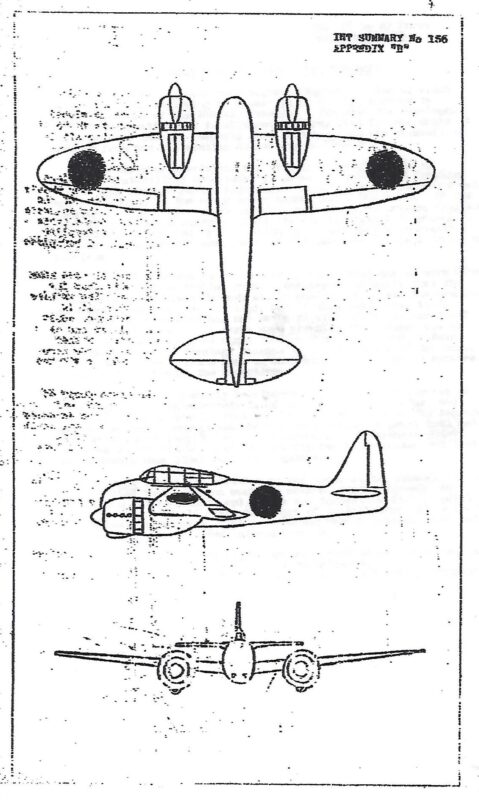
Twin Engine Diagram
SWPA Twin-engine Fighter Encounters
What was the background to the intelligence summary’s reference to a “new Japanese twin-engine fighter” and “beginning to appear in increasing numbers”? Initially we rely on Allied sources some of which seemingly add to the mystery. An incident on 19 February 1943 in which no reference was made to a twin-engine fighter may be the first encounter or at least the idea of “bombers” being involved in interceptions. A B-24 engaged Japanese fighters from the vicinity of Gasmata on New Britain Island’s south coast to a point 80 miles out to sea. The fighters involved were navy Zeros of Air Group 253. The American report, however, also mentions a Type 99 Lily light bomber (the Type 99 light bomber had been operational in the SWPA barely a month) which seemed to be observing or directing the attacks from a higher altitude. Possibly this was a misidentified twin-engine fighter new to the region gaining information about the geography, weather, local opposition and attack techniques.
A month later, March 16th, there was better evidence that a Japanese twin-engine fighter was operational. Near Ubili on the north coast of New Britain a twin-engine bomber identified as either a “Lily” or “Dinah” attacked a B-17. The Japanese “bomber” made three passes from 11 o’clock peeling off down to avoid collision each time. B-17 gunners scored effective hits, and the aircraft crashed into the sea.
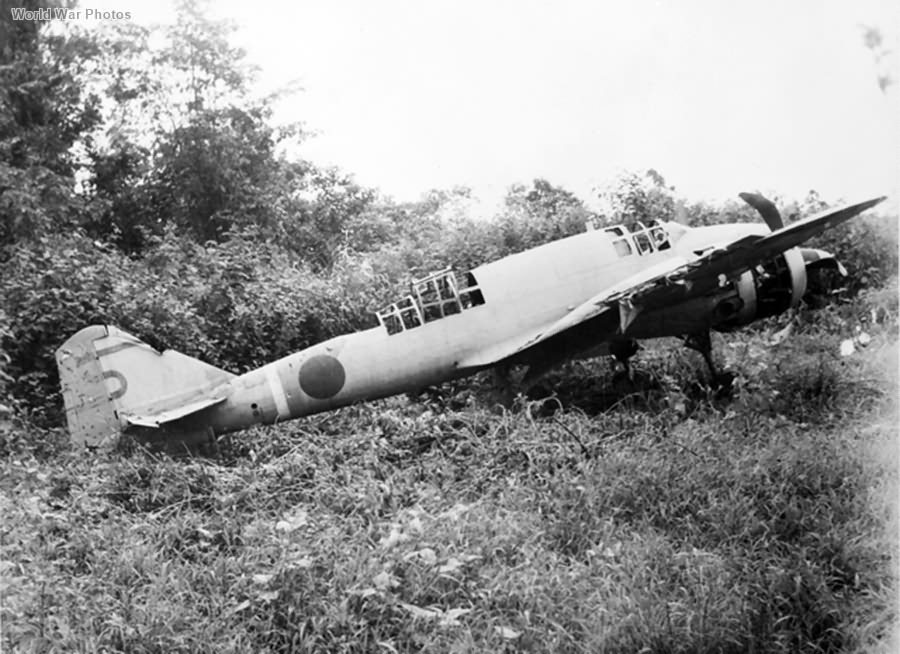
Type 100 recon captured at Gasmata
Two bodies of the crew floating on the water were strafed. That night B-17s carried out an effective attack over Rapopo the Japanese army airfield south of Rabaul. A B-17 flown by Lt. Charles Olson of the 64th Bomb Squadron was attacked by two twin-engine night fighters. He evaded by diving his big bomber and escaped in clouds.
April 1943 proved to be a pivotal month in our story. Photo reconnaissance over Wewak area airfields identified twin-engine fighters. These were distinguished from Type 100 Dinah recon planes by having a fuselage about three feet longer. Both the Dinah reconnaissance plane and the unidentified twin-engine fighter had wingspan and fuselage dimensions considerably smaller than Type 99 twin-engine light bombers. However, confusion among intelligence officers on how to interpret aerial photos regarding twin-engine fighters and light bombers persisted for several weeks into May.
On April 12th B-24s attacking shipping at Hansa Bay reported being intercepted by ten Zekes (misidentified army Type 1 fighters) and five twin-engine single-seat fighters. The twin-engine fighters reportedly broke off in half rolls to the left and steep dives. They did not press their attacks as closely as the single engine fighters. One was claimed shot down. The following day photo reconnaissance sighted four twin-engine fighters at Wewak where suspected night fighters had also been reported. On the 13th over Rabaul a single B-17 reported encountering three Zekes, a Rufe and an unidentified twin-engine fighter. On April 16th a B-24 encountered a twin-engine fighter that resembled a “Focke-Wulf FW-187” but with radial engines near Rooke Island. It was reportedly shot down in flames. Also on the 16th a B-24 on a shipping strike to Wewak in hours of darkness failed to return. Its wreckage was found twenty miles south of Bena Bena many miles from Wewak. Observers noted it was on fire before crashing. On the 26th a B-17 reported it was attacked by a Dinah with a gun in the nose in a frontal attack from 1,000 feet above. The attacker was hit and reportedly crashed in the sea.
May 20-21 brought nighttime losses of Allied bombers over both Rabaul and Gasmata. Over Gasmata an RAAF Beaufort lost was believed to be the victim of a night fighter. At Rabaul two B-17s failed to return but it was not known at the time that they fell to a night fighter. At this time an intelligence report surveying Japanese air strength commented: “In New Guinea, confusion still exists in the identification of light bombers and twin-engine fighters.” The report inaccurately attributed the rise in bomber strength at Rabaul airfields to light bombers when in fact there had been a recent influx of twin-engine fighters.
On 5 June 1Lt. Fred Hargesheimer of the 8th Photos Squadron dropped to low level to get a good view of suspected airfield development on New Britain. His F5A was hit from behind in a surprise attack by a twin-engine fighter. He bailed out and was eventually rescued. Two days later a B-17 on reconnaissance near Rabaul reported being intercepted by three twin-engine fighters resembling T. 100 Dinah. The encounters on June 10th have been mentioned above. On the 15th a B-17 over Madang reported a contact with a twin-engine fighter. The following day a B-17 on a photo reconnaissance mission to Bougainville was intercepted by Zeros. The crew misidentified some of their attackers and among them claimed one was a twin-engine fighter. On June 18th a B-17 reported an encounter with a twin-engine fighter over Karkar Island.
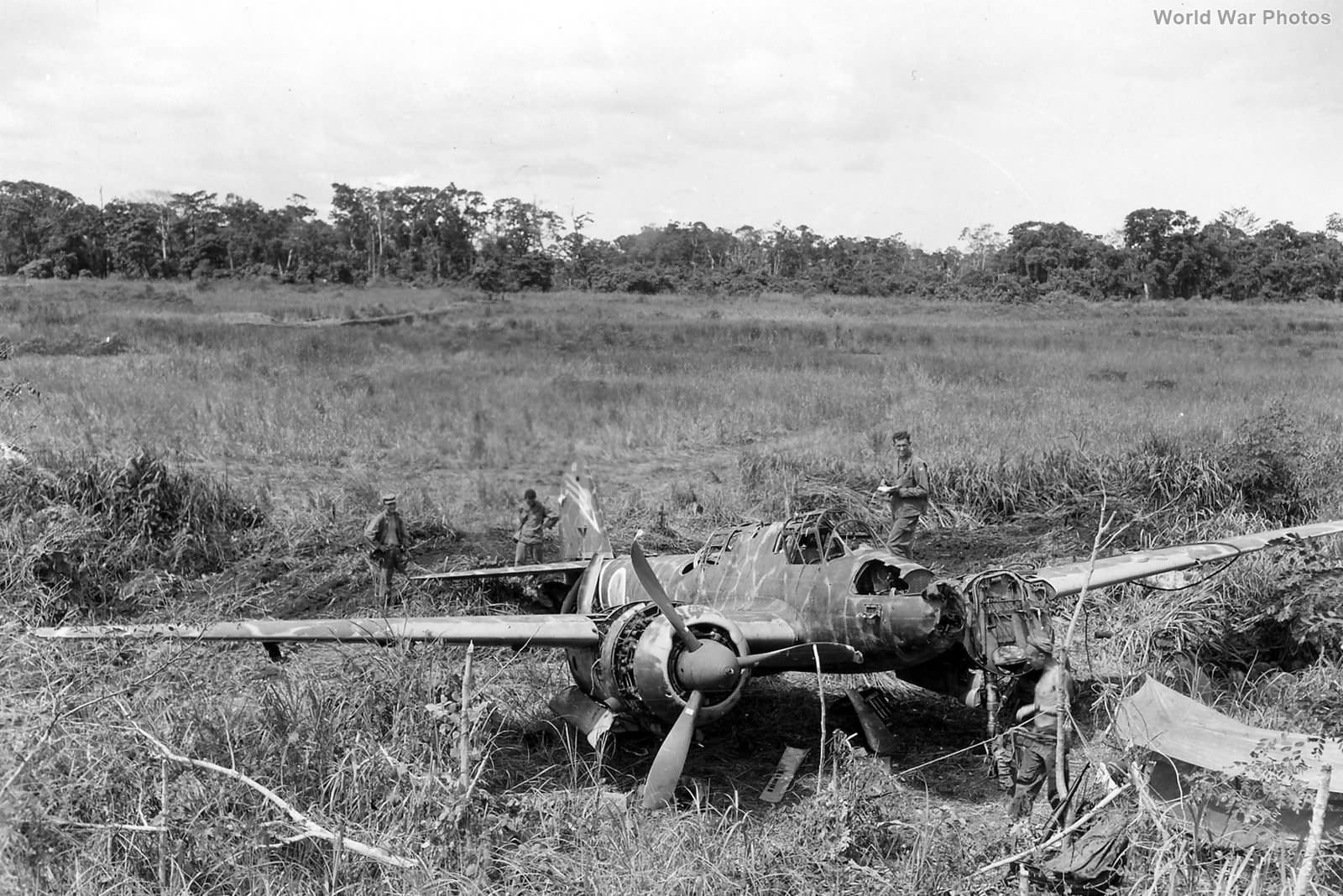
Wrecked Type 2 two-seat fighter (Nick)
Three Contributors to the Mystery
Although Allied intelligence would not solve the mystery for several months the three actors that contributed to the mystery were all in action by June 1943. One of them would leave the scene soon thereafter. The three aircraft were the (1) army T.100 headquarters reconnaissance plane (Ki 46) modified with a cannon in the nose, (2) the Type 2 Two-seat Fighter (Ki 45 Kai), and the navy’s Type 2 land reconnaissance plane (J1N1) modified with obliquely mounted cannons.
U.S. heavy bombers, the B-17 and B-24, flew long range armed reconnaissance missions as well as formation day and night bombing missions. They proved particularly difficult opponents for Japanese interceptors. In daylight, particularly formation bombing missions, their defensive armament often inflicted serious losses on intercepting fighters. Their performance, sturdy construction and protective equipment made them difficult to shoot down. At night limited visibility complicated the interceptor’s problem and a second crewman especially a radio operator was a positive factor.
The Type 100 Dinah recon plane was fast with excellent high altitude performance and long range. It was thought that with heavy armament it might be a useful counter to the Flying Fortress and Liberator.
The Type 2 Two-seat Fighter was originally conceived as an escort fighter. Its first combat came in China in June 1942 when five Toryus clashed with P-40s of the American Volunteer Group (Flying Tigers) over Guilin. Two were shot down with pilots killed, one crashed returning from the combat, and the two surviving airframes had wrinkled metal from high-g maneuvers. A clash with P-40s of the 23rd Fighter Group including some former members of the A.V.G. over Hanoi, Indo-China, in September had similar disappointing results. The Toryu proved a disappointment in dogfights but could mount heavier armament than Japanese army single-engine fighters. It was given an experimental role as a bomber interceptor.
The navy Type 2 land recon plane also started out as an escort fighter, was found unsuitable and was converted to the reconnaissance role. It appeared in that guise over the SWPA in mid-1942. One fell victim to a 41st Fighter Squadron P-39 on 2 August 1942 recorded as a “2-eng photo recon.” Like the army’s Type 100 in its reconnaissance role the navy aircraft had no forward firing armament.
Origins of the Mystery
There is a brief story that goes with each of these aircraft in their adopted role as bomber killers. The stories of the T. 100 and Type 2 “heavy fighters” are connected. In December 1942 an independent air squadron was organized within the 5th Flying Regiment in Japan. Capt. Yoshitaro Chiba the commander of 1/5th FR became the commander of the new unit. Its equipment was six each Type 100 recon and Type 2 two-seaters. The Type 100’s were modified to take a 37mm gun in the nose. The Type 2’s were modified to take a 37mm gun in the ventral tunnel normally occupied by a 20mm cannon. They also had two forward firing 12.7mm machine guns. The 37mm gun was a Type 94 Tank cannon. This was a single shot weapon. In the recon plane it was reloaded by the pilot obviously a very awkward arrangement. It took a couple minutes to reload while flying the airplane. In the Toryu it was reloaded by the rear seat gunner. Even so it took up to thirty seconds to reload limiting it to one shot per pass unless the first shot was from extreme range.
The aircraft were transported by carrier to Truk and flown to Rabaul. Records of the 14th Air Maintenance Unit indicate only eleven tank cannon and five Toryus arrived at Rabaul. One aircraft was apparently lost in the transfer flight from Truk. The first aircraft arrived in Rabaul in mid-February with transfer flights continuing into March. It appears the unit initiated operations with six Type 100’s and five Type 2’s. The squadron (chutai) reported to the 12th Flying Brigade headquarters. Records of the 14th Air Maintenance Unit indicate seven “heavy fighters” (types not specified) were operational in early May. Soon thereafter the 13th FR equipped with Toryus began to arrive at Rabaul and was assigned to the air defense of Rabaul. The independent squadron was rolled into the 13th FR and Capt. Chiba became the executive officer of that regiment. As indicated by the encounters noted above some of the heavy fighters had relocated to the Wewak area by that time. The last operational cannon armed Type 100 was assigned to the 76th Fc (independent recon squadron) and shot down intercepting bombers over Wewak. Allied intelligence began to unravel the mystery when they captured wrecks of two Type 2’s armed with the ventral 37mm cannon at Cape Gloucester in December 1943. By that time a new model with a nose mounted automatic 37mm cannon (15 rounds) was coming off the production line. It found use as both an interceptor and ground attack aircraft. Meanwhile the Allied codename Nick had been awarded to the aircraft.
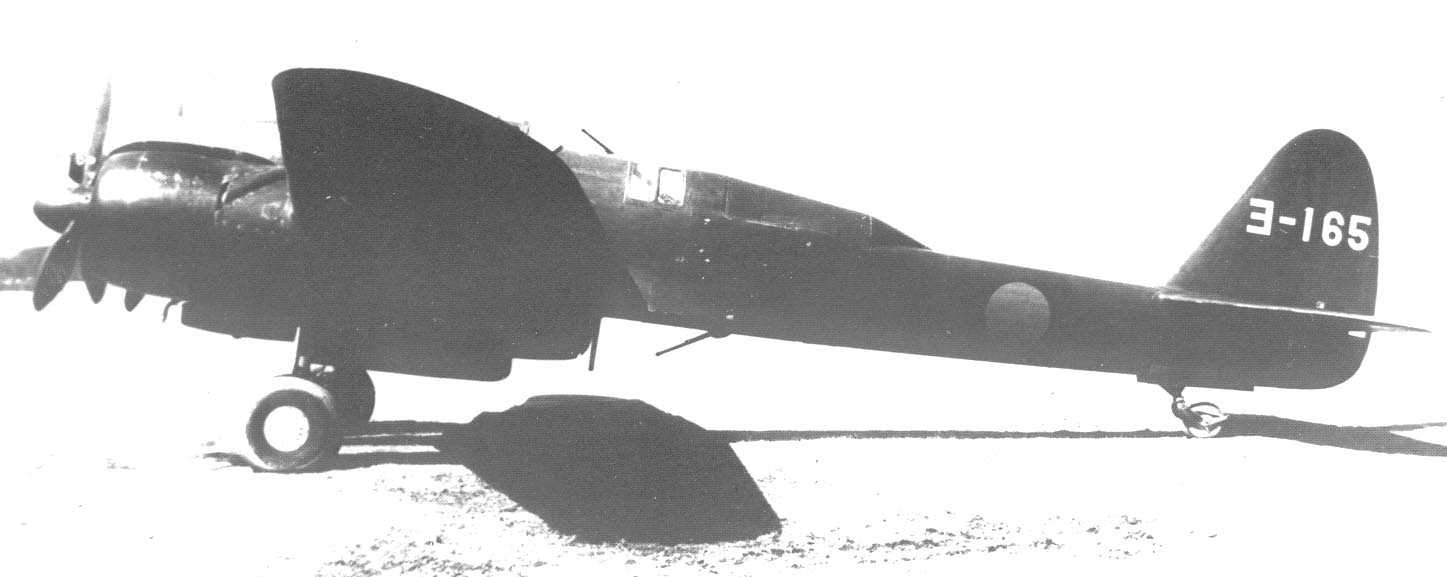
Gekko test aircraft with cannon
Two navy Type 2 land reconnaissance planes armed with 20mm cannon firing obliquely upward and downward arrived in Rabaul in early May as dedicated night fighters. They were part of the reconnaissance chutai of Air Group 251 and had been hastily modified and tested in Japan just before transfer to Rabaul. At Rabaul operational details for dedicated night fighting – airfield operations, communications, cooperation with search lights, command and control, attack techniques – were hastily worked out. The first victories were achieved on 21 May 1943. Additional success followed over Rabaul and in the Solomon Islands, and more aircraft were modified eventually on a production line basis. The modified aircraft received the official designation of Gekko or Moon Light. Eventually the Allies awarded the aircraft the code name Irving.
What was the mystery twin-engine fighter?
There was no single mystery fighter. The sketch or plan in the Northern Territory intelligence summary closely resembles the Type 100 reconnaissance plane and the description says it had the dimensions of the Dinah. However, the evidence suggests that of over 1,700 Dinahs produced in various models only the half dozen sent to Rabaul in early 1943 were fitted with the 37mm tank cannon. The service life of these aircraft was only about six months. Late in the war some T.100 model III’s were fitted with cannon armament for intercepting B-29s over the Japanese homeland. About twenty Type 2 Two-seat fighters were fitted with the Type 94 tank gun among which were the six assigned to the special attack unit in December 1942. Over 1,600 Toryus were produced. All were cannon armed with either 20mm cannon or 37mm single shot or automatic cannon. Total production of navy Type 2 land reconnaissance/Gekko night fighters numbered over 450 aircraft. In addition to those purpose built as fighters many of the reconnaissance version were converted to night fighters. The fighter appearing in the intelligence sketch suspected of being a version of the Dinah reconnaissance plane was among these three aircraft, the one produced in the fewest numbers and operational for the shortest period of time.
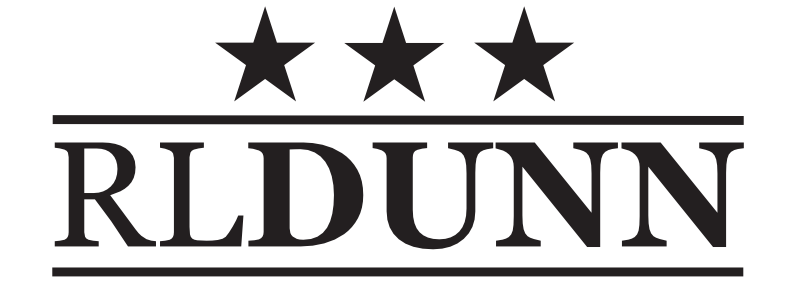
Excellent analysis!
Thank you Rick for all your work and your tenacity in getting things right!